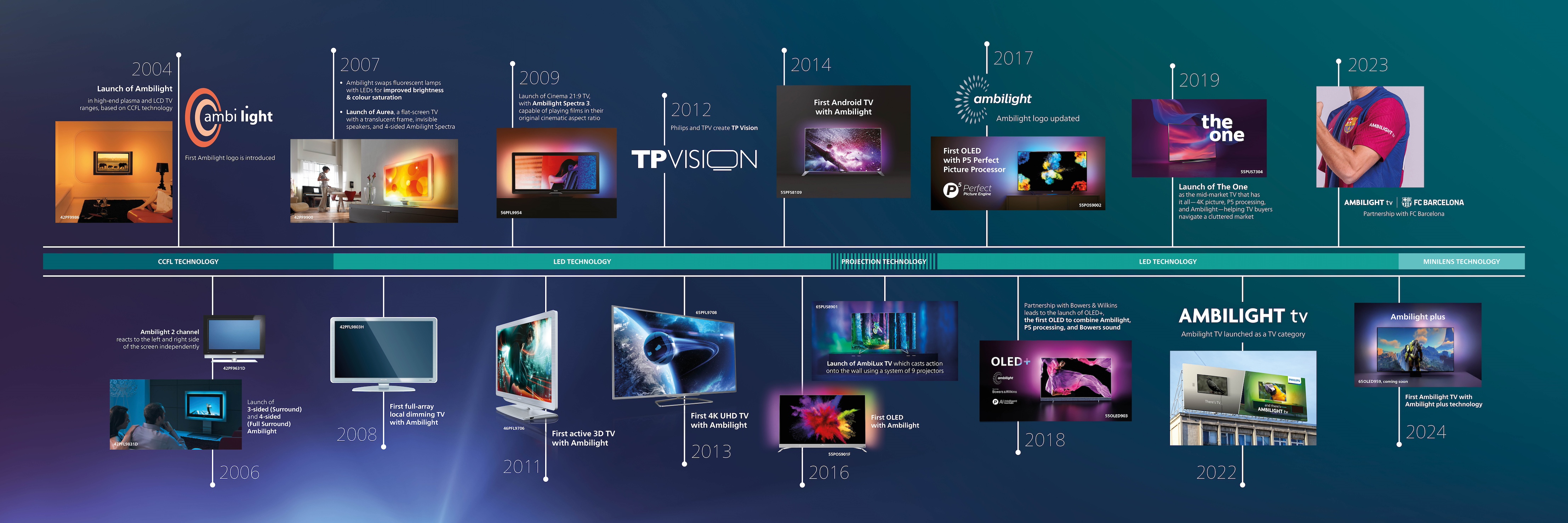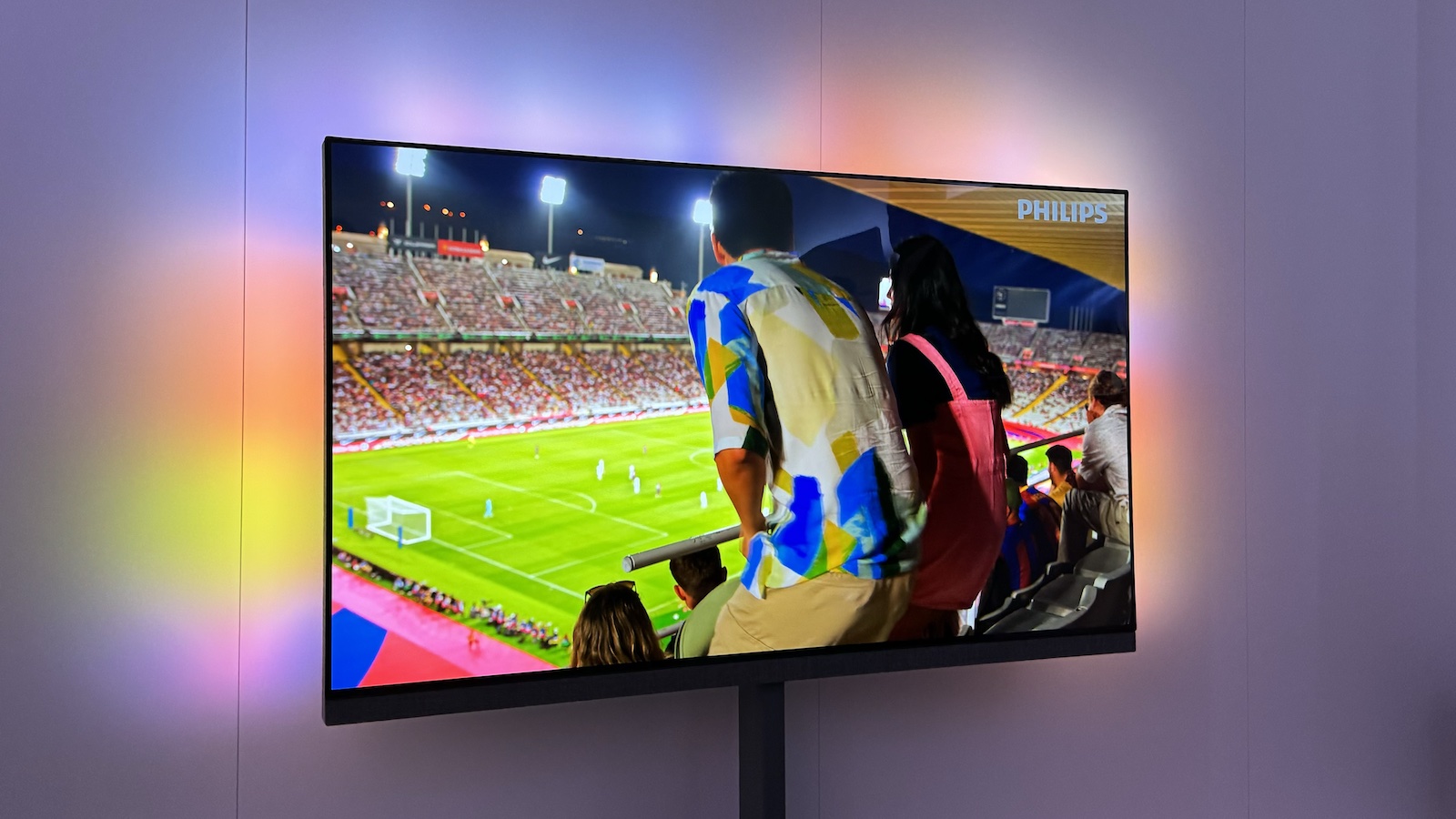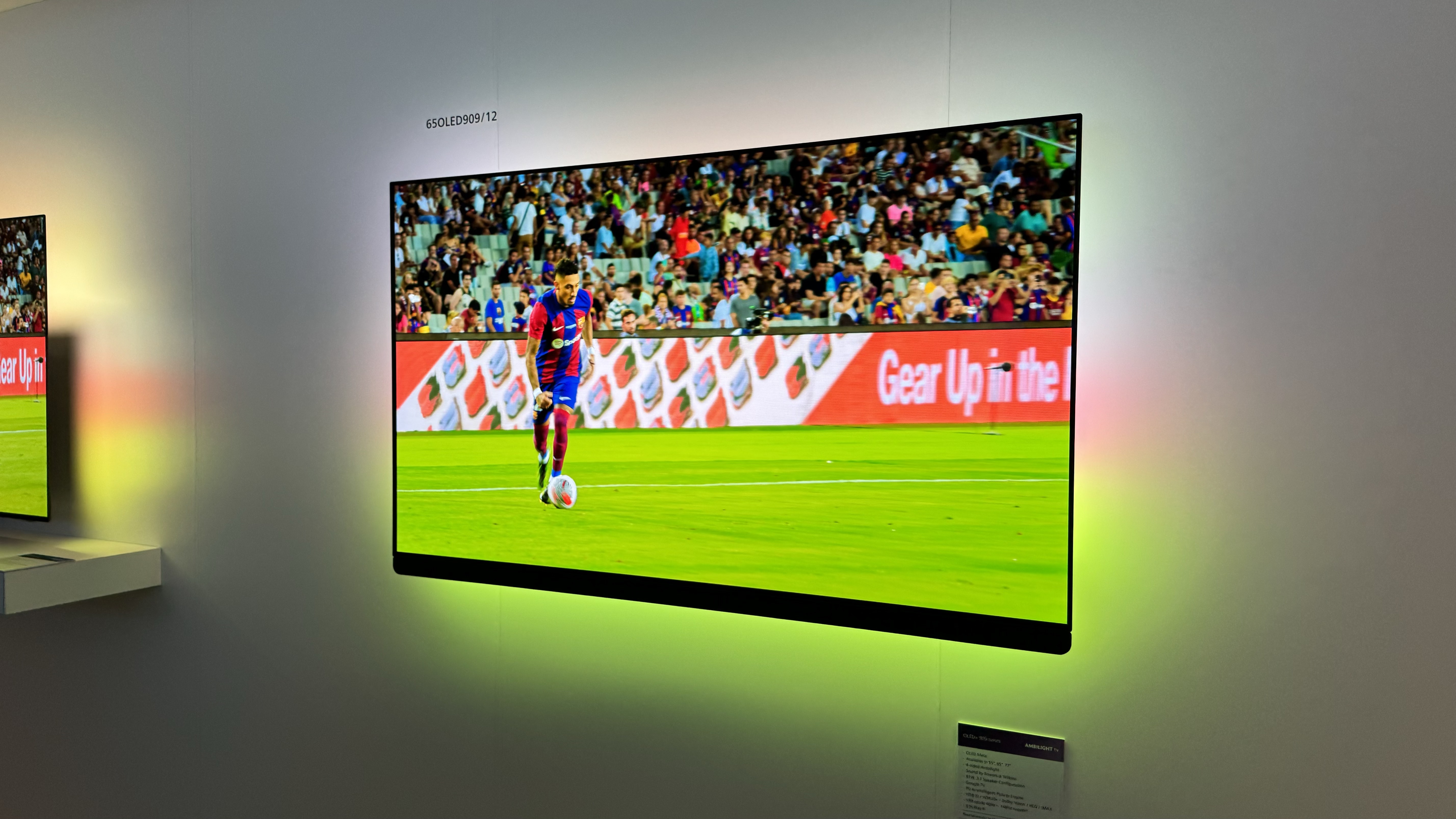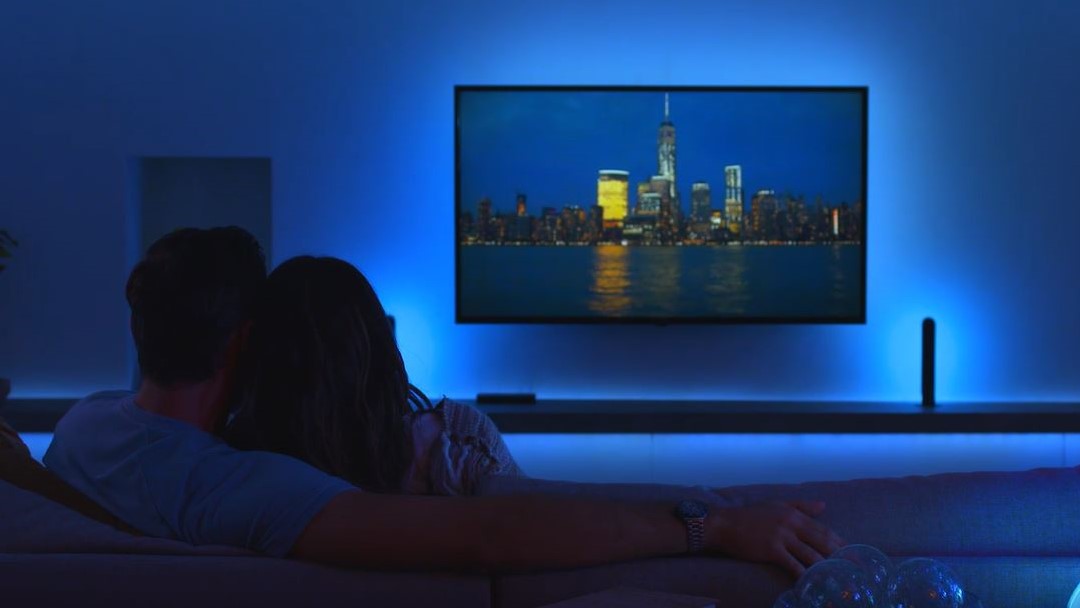What is Ambilight? Is the Philips TV technology worth it?
We shed some light on Philips' TV tech

The best TVs often have the same features, and even the same screen panels, but one manufacturer offers something unique. Select Philips TVs have come with built-in Ambilight tech since the early 2000s – Philips claims this makes the picture more immersive while also easing the strain on your eyes.
But what exactly is Ambilight? How does it work? And is it a gimmick, or – as the light brigade would have you believe – something that genuinely enhances your movies, shows and games? Allow us to shed some light on the matter.
- Check out Philips' latest OLED TVs
What is Ambilight?

Ambilight is a way of expanding the TV's picture beyond the confines of the set. It does this through a series of coloured lights placed around the rear of the TV's frame. These match up with what's on screen to beam the corresponding colour onto the wall behind it. The theory is that this draws in your eye, making the picture more immersive.
It's most effective with films, games and other visually stunning content watched in a dark room, less so with Lorraine in bright sunlight.
When did Ambilight launch?

Ambilight launched in 2004 in Philips' high-end plasma and LCD TVs, but it wasn't until 2006 that Philips introduced different colours for different edges of the screen – first came two-sided, in which the left and right side reacted independently, then three-sided (known as Surround Ambilight) and finally four-sided (Full Surround).
In 2007, Ambilight switched from using fluorescent lamps to LEDs for better brightness and colour saturation. Philips also launched Aurea, a TV with a translucent frame, hidden speakers and four-sided Ambilight.
The first full-array local dimming TV with Ambilight launched in 2008, while 2009 saw the introduction of Ambilight Spectra 3, which combined Ambilight tech with the more cinematic 21:9 aspect ratio.
The latest hi-fi, home cinema and tech news, reviews, buying advice and deals, direct to your inbox.
In another first, Philips launched an active 3D TV with Ambilight in 2011, and the first 4K model with the technology in 2013.
The first Android TV with Ambilight landed in 2014, and the first OLED with the tech in 2016.
In 2018, Philips partnered with Bowers & Wilkins to launch an Ambilight TV featuring the British company's sound tech. This was followed in 2019 by The One, a mid-market TV that combined 4K visuals with Ambilight.
In 2022, Ambilight TVs launched as a separate range of TVs, while 2024 saw the introduction of the first TV with Ambilight Plus. The Philips OLED+959 will go on sale in September.
How does Ambilight work?

Ambilight TVs feature a row of rear-mounted 'intelligent' LEDs on each side. These read the picture information going to the screen and mirror the colours in the corresponding part of the picture – so if there's a red race car in the bottom left part of the screen, the Ambilight LEDs will project the same shade of red onto the wall behind.
Philips says this happens in real time, and in our experience, that's pretty much true. With older versions of Ambilight, there was a slight delay, which marred the viewing experience – it was akin to the audio being ever so slightly out of sync. But as the technology has progressed, this has become much less of an issue.
Ambilight works best in a dark room with a wall behind the TV to catch the light from the LEDs.
What are the benefits of Ambilight?

If you listen to Philips, Ambilight's benefits are many and varied. It claims that the light effectively expands your screen beyond the frame of the TV, drawing you into the picture and making it more immersive. It also says it makes the screen easier on your eye, as instead of constantly adjusting between the bright picture and dark surroundings, the light infuses the surroundings, reducing the contrast between them and the screen and reducing eye strain and fatigue.
Our take? It varies from person to person, even among the What Hi-Fi? reviewers. Some find it more immersive while others find it distracting and prefer the purist experience of a screen in a dark room. There is clearly some evidence to suggest that having bias lighting helps reduce eye strain, but some people would argue that simply turning the lights on low will help with that.
We do like Ambilight for the overall effect it creates, though. It's not for everyone, but with the right kind of content, we really like the ambient lighting it gives off. Host a movie night, and it's guaranteed to impress your guests. And if you're watching Barbie, you can see how your lounge would look painted pink.
It's worth noting that you can adjust the intensity of the Ambilight effect, or turn it off entirely (which you may well want to do depending on what you're watching). So it's not a case of all or nothing.
What can you watch with Ambilight?

Pretty much anything. It works with movies, TV shows, games, streaming services, DVDs... it can even create a light show to match whatever music plays through your TV.
Though we must stress this: it will work better with some types of content than others. Anything with bright, distinct colours will create a stunning effect – character-led dramas, less so.
You can even activate Ambilight when you're not watching anything. Lounge mode throws out light with nothing on the screen, which is handy if you don't have diffuse lighting and don't want the harsh glare of the ceiling bulb. And the Aurora gallery lets you choose from various artworks, with the LEDs mimicking whatever's on screen as they do with moving content.
What different types of Ambilight are there?

Ambilight Plus is the latest version. It replaces the flat light strips with dome-shaped lenses. With multiple lenses mounted to the LEDs, it provides a "more dynamic, larger overall halo with more resolution", according to Philips. It can also project up to four different halos at different depths to add a new two-dimensional impact.
We went eyes-on with it recently, and were impressed. It did seem brighter, more detailed and more responsive, as Philips had promised. While standard Ambilight can look a bit hazy, Ambilight Plus has a shimmering effect that resembles lights being reflected in ripples of water. The light has more shape to it as well – while it doesn't show exact objects, there are more colours within each section, so a football match might be represented by a swathe of green for the pitch with red and yellow dots being the players on opposing teams. It responds much more quickly to what's happening on-screen too, making it more dynamic.
Ambilight Plus will launch on the Philips OLED+959 in September.
But it's not the only version of Ambilight in existence. In 2023, Philips launched Ambilight V2, which matches more precisely to your room's lighting conditions. Ambilight V2's XYZ light sensor measures the colour temperature of your room, and matches the screen image's white point to your room's ambient lighting, which makes Ambilight more immersive. It launched on the Philips OLED808 and OLED908.
Previously, Ambilight came in a two-sided version, and now comes in both three- and four-sided varieties.
There are also various modes within Ambilight. The standard – and most effective – option is to have it react to the on-screen action, but you can also have it follow the sound (which works better for music than visual content), work as a single colour backlight, or – bizarrely – have the lights show up a country flag behind your TV. You can also select from preset modes such as Football, Relax and Natural to vary the responsiveness and intensity depending on what you're watching or what mood you're in.
Ambilight has expanded beyond the TV too. The Fidelio FS1 speaker comes with Ambilight built-in to extend the lighting effect further across the room – eight LEDs built into the speaker's rear let it synchronise with the Ambilight from a Philips TV. It can work as a standalone speaker, as half of a stereo pair, or as a satellite in a surround sound set-up.
Older Philips TVs could also sync with Philips Hue smart lighting to extend the light show around the house, but Philips has since canned this feature.
What Philips TVs use Ambilight?
Ambilight Plus comes as part of the Philips OLED+959, which launches in September. But plenty of other Philips TVs feature different forms of Ambilight – if it's mid-range or above, there's a good chance Ambilight is part of the package.
To compare Ambilight models, head to the Philips website.
Does Ambilight work with other makes of TVs?

Philips TVs are the only ones that come with Ambilight built-in, but it has extended the offering to Samsung TVs. The Philips Hue Sync TV App for Samsung TVs lets you sync your Philips Hue lights to what's happening on your Samsung TV's screen.
The app works with Samsung TVs from 2022 and later. Here's how to set it up. You'll also need a Philips Hue Bridge and some Hue colour compatible lights.
Previously, Philips launched an HDMI sync box that performed the same function, but it was expensive and took up a precious HDMI socket that could be used for a soundbar or games console.
Does Ambilight work with Philips Hue?

While Samsung's TVs can work with your Philips Hue smart lighting, newer Philips TVs can't. In 2023, Philips announced its newer Ambilight TVs would lose the Ambilight+Hue feature that let them sync with Philips' smart lighting, blaming low uptake from consumers and Ambilight's increasing sophistication as a technology. It's certainly fast-moving, as the introduction of Ambilight V2 in 2023 and Ambilight Plus in 2024 go to show.
Where it goes next is anyone's guess, but it's sure to remain one of the most innovative (and divisive) TV technologies for years to come.
MORE:
Pre-purchase checklist: 7 things you must check before you buy a new TV
Check out our reviews of the Philips OLED808 and Philips OLED908
And our round-up of the best OLED TVs you can buy right now
Joe has been writing about tech for 20 years, first on staff at T3 magazine, then in a freelance capacity for Stuff, The Sunday Times Travel Magazine (now defunct), Men's Health, GQ, The Mirror, Trusted Reviews, TechRadar and many more. His specialities include all things mobile, headphones and speakers that he can't justifying spending money on.

